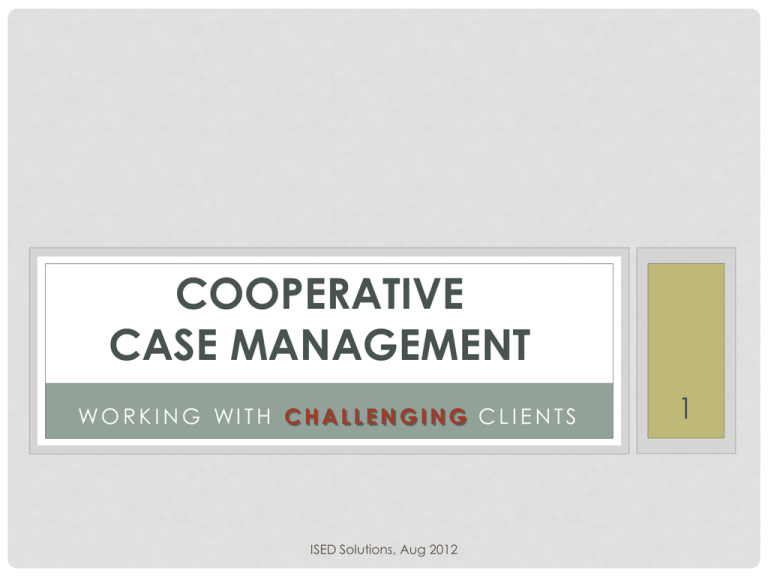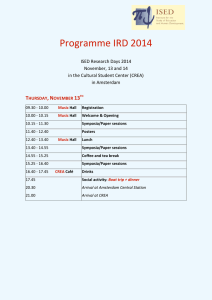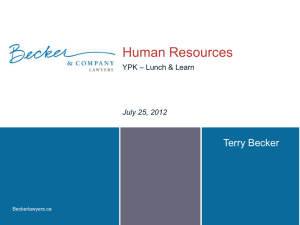Dealing with Challenging Clients - ISED Solutions
advertisement

COOPERATIVE CASE MANAGEMENT WORKI NG WI TH CHALLENGING CLI ENTS ISED Solutions, Aug 2012 1 ACKNOWLEDGEMENTS This training is based on selected works of: • David Moxley • Linda Albert • Albert Ellis • Alfred Adler • Stephen Covey • The Harvard Negotiation Project ISED Solutions, Aug 2012 2 WHAT WILL YOU GET IN THIS TRAINING? • Validation of your strategies and methods • Techniques to create more “good time” with clients • New ways to think about case management interactions • New tools to use with clients ISED Solutions, Aug 2012 3 WORKING WITH CHALLENGING CLIENTS CASE MANAGEMENT PRACTICE ISED Solutions, Aug 2012 4 DEFINITION OF CASE MANAGEMENT The organization and coordination of a network of formal and informal activities, services, and supports designed to optimize the well being of a person. Source: Moxley, Practice of Case Management (1989). ISED Solutions, Aug 2012 5 OPTIMIZE……. to make as effective or functional as possible ISED Solutions, Aug 2012 6 WHICH MEANS…………… Reducing barriers Enhancing strengths “Only what is needed” ISED Solutions, Aug 2012 7 REMEMBER You are the Professional ISED Solutions, Aug 2012 8 THE PROFESSIONAL “YOU” You ARE: You are NOT: • Case manager • Teacher • Coach • Cheerleader • Guide • Parent • Sister or Brother • Psychologist • Priest/Cleric • Friend ISED Solutions, Aug 2012 9 ISED Solutions, Aug 2012 10 WORKING WITH CHALLENGING CLIENTS UNDERSTANDING WHAT MOTIVATES INDIVIDUALS ISED Solutions, Aug 2012 11 ISED Solutions, Aug 2012 12 Fear of failure, of the unknown, of success Overwhelmed! Culture Shock Feels powerless, perceives a lack of options Cultural and value differences Impaired, traumatized, paralyzed Conflict gets attention ISED Solutions, Aug 2012 13 SEVEN BASIC ADLERIAN CONCEPTS 1. 2. 3. 4. People are social beings Behavior is goal oriented Our primary goal is to belong A difficult client may be a discouraged client 5. Everyone needs to have social interaction 6. All people have equal claims to dignity and respect 7. Everyone needs to believe others care about them based on the work of Alfred Adler and Linda Albert ISED Solutions, Aug 2012 14 THE THREE C’S: Every person •Capable needs •Connected to be •Contributing …… ISED Solutions, Aug 2012 15 WORKING WITH CHALLENGING CLIENTS THE COOPERATIVE CASE MANAGEMENT APPROACH ISED Solutions, Aug 2012 16 PREMISES OF COOPERATIVE CASE MANAGEMENT Clients make choices about how they choose to experience the resettlement process. All clients have the potential to make good choices in the planning processes. Case managers make choices about how to work with clients: hands off, hands on, hands joined. ISED Solutions, Aug 2012 Treat clients with respect as important decision makers who have the right to participate in the design of their experience. 17 COOPERATIVE CASE MANAGEMENT: Encourages “hands – joined” approach ISED Solutions, Aug 2012 18 THE THREE C’S: The goal of every client is to be: • Capable • Connected • Contributing ISED Solutions, Aug 2012 19 TWO OF YOUR BEST TOOLS Rights & Responsibilities •Explain every item in detail •It gives the client an active role in the resettlement process Family Self-Sufficiency Plan •Remind the client this is their plan—you are guiding them based on your experience and knowledge ISED Solutions, Aug 2012 20 MANAGING CLIENT EXPECTATIONS Listen to their stories Explain the resettlement process and their options Engage them in creating the plan Create clear, specific, attainable and beneficial goals ISED Solutions, Aug 2012 21 ISED Solutions, Aug 2012 22 WINNING COOPERATION “People whose lives are affected by a decision need to be a part of the decision-making process...” John Naisbitt Megatrends “...if you want them to cooperate.” Linda Albert Cooperative Discipline ISED Solutions, Aug 2012 23 SUCCESS FACTORS FOR CASE MANAGER & CLIENT RELATIONSHIP Create a positive atmosphere in your space Commit to a high-quality relationship Build client self-esteem Encourage decision-making skills Allow for clients to take responsibility and make choices ISED Solutions, Aug 2012 24 WORKING WITH CHALLENGING CLIENTS UNDERSTANDING CHALLENGING BEHAVIORS ISED Solutions, Aug 2012 25 WHEN CLIENTS “ACT OUT” They are typically seeking... • Attention • Power • Revenge • Avoidance of failure ISED Solutions, Aug 2012 26 COMMON BELIEF SYSTEMS • Attention: I only count when I’m the center of attention. Look at me! • Power: I only count when I’m in charge and doing things my way. I win. Let’s fight! • Revenge: When people hurt me, I have to hurt them back. I’ll get even! • Avoidance of failure: I will never belong here or have value. I’m not good enough. Nothing I do is ever right. Leave me alone! ISED Solutions, Aug 2012 27 ATTITUDE IS A JOURNEY “Our attitude towards what has happened to us in life is the important thing to recognize. Once hopeless, my life is now hope-full, but it did not happen overnight. The last of human freedoms--to choose one's attitude in any given set of circumstances-- is to choose one's own way.” Viktor Frankl, Man’s Search for Meaning ISED Solutions, Aug 2012 28 HOW DO WE HAVE FEWER DAYS LIKE THIS? TECHNIQUES TO DEAL WITH CHALLENGING BEHAVIORS ISED Solutions, Aug 2012 29 A LITTLE ENCOURAGEMENT GOES A LONG WAY… Remember: A difficult client may be a discouraged client “I can go for two months on a good compliment.” Mark Twain • When defined using the root meaning of courage, encouragement is, “the process of facilitating the development of a person’s inner resources and courage toward positive movement” (Dinkmeyer and Losoncy in Cheston, 2006) ISED Solutions, Aug 2012 30 ISED Solutions, Aug 2012 31 38 APPROACHES FOR DEALING WITH CHALLENGING BEHAVIORS 1. Challenge the behavior, not the person: Avoid labeling the person 2. Take charge of your emotions: Stop…look….listen… 3. Avoid escalating the situation: Don’t pick up the rope! 4. Allow the client to save face “You can’t shake hands with a clenched fist.” -Ghandi ISED Solutions, Aug 2012 32 SEPARATE BEHAVIOR FROM IDENTITY: AVOID LABELING It’s important to separate the client’s challenging behavior from his or her identity as a person. Subconsciously, you may label your clients and expect them to behave the same way every time. For example, your inner-talk about your client, Ahmed, may go something like this, “Oh, he is such a pain; he's going to complain about anything I suggest. I can’t stand dealing with him.” This mindset negatively impacts the nature and outcome of the conversation. Resist the temptation to label or judge, even if the behavior is really irritating. Adapted from D. Berenbaum, Communico LTD. http://www.communicoltd.com/pages/465_six_strategies_for_dealing_with_difficult_people.cfm ISED Solutions, Aug 2012 33 I SEE YOU… Seeing vs. Stereotyping (from Stephen Covey, “The 3 rd Alternative”) I See You I Stereotype You SEE I see a human being with worth, talent, passions, and strengths. You deserve dignity and respect. I see a difficult client…from a difficult “group.” You are a symbol of conflict for me. DO I demonstrate authentic respect for you. I listen to you views. I try to control you, ignore you, or deal with you quickly to get you out of my way. GET An atmosphere of cooperation where we are stronger working together. An atmosphere of hostility where we are weakened and neither of us is successful. ISED Solutions, Aug 2012 34 MANAGE YOUR EMOTIONS Stop… Take a break from the conversation Look…. What’s behind the behavior? Listen…. Move from certainty to curiosity You haven’t “heard it all” Before you respond! ISED Solutions, Aug 2012 35 THE DESTRUCTIVE DON’TS • Getting angry • Nagging • Yelling • Lecturing • Threatening • Being sarcastic • Humiliating • Ignoring (giving up) ISED Solutions, Aug 2012 36 HOW DO YOU WANT TO BE REMEMBERED? Your clients won’t always remember what you said, but they will always remember how you treated them! ISED Solutions, Aug 2012 37 AVOID ESCALATING THE SITUATION • When clients are being difficult, our first reaction might be to defend ourselves or to argue with them. It’s almost as if they can set you up to make your lose your cool! Disengage the moment emotions begin to escalate • A brief look at brain chemistry: once your brain perceives a threat, the survival mechanism kicks in, urging you to “fight” or “flight.” It’s a downward spiral from there…so… ISED Solutions, Aug 2012 38 DON’T PICK UP THE ROPE! Once you pick up the rope, you are in a power struggle and it won’t end well. ISED Solutions, Aug 2012 39 DON’T PLAY TUG OF WAR! ISED Solutions, Aug 2012 40 FACE SAVING OPTIONS The “And Stance…” • When we have conflict with someone, we typically assume we must either ACCEPT or REJECT their story, viewpoint, or ideas…and if we ACCEPT theirs, we must ABANDON ours. • The “And Stance” give you the ability to understand and validate the other person’s viewpoint without giving up your own. • The client can save face, AND you can continue to explain why things are done a certain way, or why one option is better than another, etc… • It’s very helpful in situations when you must give bad or unwelcome news, or implement a decision that is unpopular. ISED Solutions, Aug 2012 41 “AND STANCE” EXAMPLES… • A client is angry because his apartment is several blocks farther from the bus station than his friend who arrived a few months after he did. • Typical response: I’m sorry you are angry, but we did the best we could to find you a good apartment. That apartment building was full when you arrived but it had an opening when he arrived… • “And Stance” response: I understand this is upsetting AND it happened because that apartment was not available when you arrived AND I know you have a long walk to the bus station AND we can continue to help you look for an apartment closer AND you’ll be able to afford it once you’ve been working a few months…. ISED Solutions, Aug 2012 42 “AND STANCE” EXAMPLES… A client who wants a lot of attention comes to see you every day, interfering with your ability to serve other clients. Typical response: “I know you want to see me but I’m busy here. A lot of people need my help– I just don’t have time. You’ll have to come back tomorrow.” “And Stance” response: “I know you want to see me AND I understand you are frustrated AND I need to serve a lot of people today AND I will try to make some time for you AND if I can’t I will set an appointment for you tomorrow AND we will talk then… ISED Solutions, Aug 2012 43 We must make sure that the message of caring gets through ISED Solutions, Aug 2012 44 DEVELOP AN HONOR CODE TO SHARE WITH YOUR CLIENTS • We will treat each other with Respect. • We will take Responsibility for our actions. • We will honor Reliability. • We will act with Integrity. ISED Solutions, Aug 2012 45 I make a difference ISED Solutions, Aug 2012 46 REFLECTION ACTIVITY 1. One important thing I’ve learned is . . . 2. One thing I have relearned is . . . 3. One thing I am going to do differently is . . . Please email your answers to meredith.lee@isedsolutions.org. We will compile the responses and include them with the PowerPoint of this webinar that will soon be available on line. ISED Solutions, Aug 2012 47 THANK YOU! FOR MORE INFORMATION, PLEASE CONTACT: Peggy Gilbert Senior Program Advisor, ISED Solutions peggy.gilbert@isedsolutions.org Meredith Lee Senior Researcher, ISED Solutions meredith.lee@isedsolutions.org ISED Solutions, Aug 2012 48







